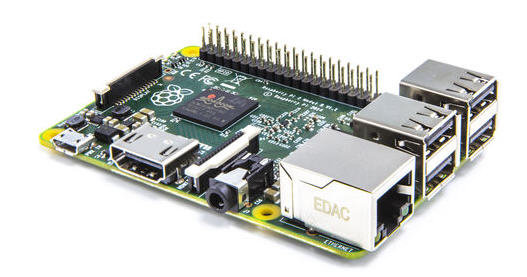
Raspberry Pi 2. Raspberry Pi
By Simon J Cox and Steven Johnston
The Raspberry Pi has been a great success, selling millions since launch in 2012 and igniting hobbyists' imagination everywhere. The Pi is a tiny computer at a tiny price, but now the arrival of a seriously upgraded Raspberry Pi 2 has brought the performance that the first lacked, in a package the same size at the same cost of US$35.
The Raspberry Pi 2 Model B, to give its full name, bumps the memory (RAM) from 512Mb to 1Gb, and introduces a 900mhz quad-core ARM Cortex-A7 processor. The new board also requires less power and is pin-compatible with previous boards so it will be backwards-compatible with existing projects.
Simon’s son, James, has been a bit click-happy when programs are loading. A little more horsepower and memory might avoid seeing multiple copies of programs load up as an impatient eight-year-old wonders: “Did I click it? Let me just click again.”
We built a 64-node Raspberry Pi cluster at Southampton in 2012, and it made a great demonstrator, but the low processor performance really limited the possibilities.

Raspberry Pi Supercomputer using original Model B and Lego Simon Cox
A quad-core Pi cluster will not only perform better (an estimated six times better, according to the Pi team) but also provide performance closer to real world high-performance computing systems, which have all moved to multi-core processors. It will allow us to show simple examples from some of the real simulation code we use in science and engineering, which struggle to even run on the previous Pi model.
We hope this will further help to inspire the next generation of scientists and engineers about how we use computers to understand the world around us, and how we develop code for much larger high-performance computers – and all at a much lower cost than the millions of pounds required for large supercomputers.
Windows in a tiny footprint
For us, the biggest opportunity is that Microsoft has confirmed it will deliver a version of its Windows 10 operating system that runs on the Raspberry Pi 2 – free of charge for hobbyists through the Windows Developer Program.
This makes it a truly versatile piece of hardware that provides the best of both worlds: a Linux and Windows-compatible device with a tiny footprint which is ready for use with Internet of things-related projects, equipped as it is with hardware pins to attach it to external devices and sensors (which are also supported by Windows 10).
With Windows come all the development tools such as Visual Studio, libraries and languages such as C# to add to the many tools that can already run on the Pi such as Scratch and Python.
Sweetness in the cloud
We’re also excited by the possibility Windows 10 brings of connecting Raspberry Pi devices to the cloud, and the Windows development tools should make this much more straightforward. Most of us are familiar with using the cloud for email, storing pictures, and social media. But for our research work in science and engineering the cloud gives us access to huge, shared computing power and data storage, with which we can simulate the complex ways in which tiny molecules interact, or astrophysical calculations on how the universe works.
We can also use the cloud to analyze data collected from thousands of sensors on Raspberry Pi-based Internet of things devices. For example, these might be sensors in a rainforest to enable us to understand and make better decisions about the effect of human behavior on the environment. Across a transport network ubiquitous sensors might also help ease traffic flow through our ever increasingly congested cities and motorways.
Community, community, community
While there are other similar devices out there such as the Arduino, BeagleBoard, Odroid and many others, for us the community that has developed around Raspberry Pi is absolutely key to its success. The community is huge, friendly, and everyone is keen to share their experiences and help out.![]()
If the predictions of 26 billion Internet of things devices by 2020 are to be realised it will require the sort of easy-to-program hardware and supportive community of developers that has been catalyzed by Pi. And with the addition of Windows support, that community looks set to grow to include many more.
Simon J Cox, Professor of Computational Methods, Director, Microsoft Institute for High Performance Computing, Associate Dean at University of Southampton, is Director of the Microsoft Institute for HPC (at University of Southampton). He receives funding from UK Government Research bodies and Industrial companies including Microsoft. Steven Johnston,
Senior Research Fellow for the Faculty of Engineering and the Environment at University of Southampton, receives funding from UK Government Research bodies and Industrial companies, including Microsoft. This article was originally published on The Conversation. Read the original article.




Comments